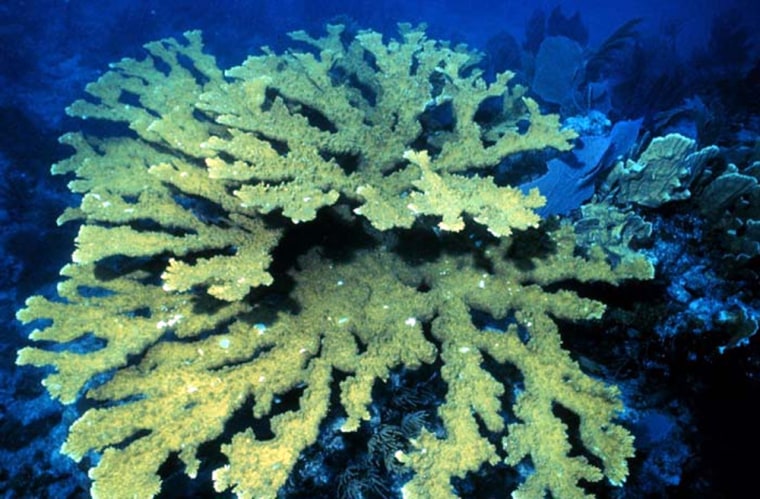In two major conservation decisions, the Bush administration has finalized a controversial policy on trade in endangered beluga sturgeon while also proposing that two coral species, staghorn and elkhorn, be listed as “threatened” under the Endangered Species Act.
It would be the first time any coral species was found needing government protections to avoid extinction. In the United States, the two species are found in shallow water throughout Florida. They grow best in clear water free from excess nutrients, runoff or algal blooms.
"These formerly abundant corals have remained at low levels without noticeable recovery, and in cases where we have targeted monitoring data, they continue to decline," Conrad Lautenbacher, head of the National Oceanic and Atmospheric Administration, said in a statement. “Threats to these species include physical damage from human activities and hurricanes, as well as disease and temperature-induced bleaching.”
Conservation group pleased
The agency's proposal was in response to a petition from the Center for Biological Diversity.
“This is a great day for science, conservation, and the great state of Florida,” Brent Plater, lead author of the petition, said in a statement.
Direct “take” of the corals will be prohibited, critical habitat areas will be protected, and recovery plans will be implemented once the proposal becomes law, the center noted.
The center also cited global warming as a serious threat since coral are very temperature sensitive. Emissions of carbon dioxide and other "greenhouse" gases tied by many scientists to warmer temperatures should be factored in, the center argued.
“Requiring greenhouse-gas emitting industries to consider how their activities are impacting our most productive marine ecosystems is not only right in principle but also eminently sensible,” Plater said. “The destruction and loss of these coral species and therefore the loss of a major portion of the Florida-reef tract ecosystem will result in the loss of billions of dollars to our economy, the loss of an unknown number of medicines, and decimate local biodiversity. It’s just common sense to consider these impacts before it is too late.”
Caviar controversy
On the issue of beluga sturgeon, the new regulations take effect Friday and require that countries seeking to expert the fish and/or its caviar to the United States must:
- Provide assurances that they can conserve populations of beluga sturgeon.
- Meet U.S. standards for aquaculture, or fish farming, to prevent mixing of species by wild and farmed sturgeon.
Kenneth Stansell, the Fish and Wildlife Service’s assistant director for international affairs, said the aim is to create “a long-term conservation program to encourage recovery of the species.”
The announcement by Fish and Wildlife makes final its decision not to impede U.S. trade in beluga sturgeon, its eggs or its meat. Last April, the agency agreed to list the beluga sturgeon as threatened, a lesser category than “endangered,” based on a petition in December 2000 from a U.S.-based environmental coalition, Caviar Emptor.
The agency, however, rejected the coalition’s request for a ban on trade in beluga sturgeon. Most of the world’s beluga caviar is imported by the United States, usually originating from the Caspian and Black seas.
The Natural Resources Defense Council had sued Fish and Wildlife in 2002 to force the agency to respond to the petition — which said there had been a 90 percent decline in the fish’s population between 1980 and 2000.
Since beluga sturgeon take 15 years to reach maturity, they reproduce slowly and their population is more vulnerable to overfishing, said Ellen Pikitch, a marine scientist and executive director of the University of Miami’s Pew Institute for Ocean Science.
“The idea that this fish could go extinct is not a fantasy,” she said. “The science shows that the best chance for recovery of beluga would have been to give the beluga a complete break, and the decision today fell far short of that.”
Rule details
The regulations allow U.S. importers to continue to bring in caviar and the meat of beluga sturgeon, but only from nations around the Caspian and Black seas that meet six new standards.
In six months exporting countries will have to show plans and timetables for helping the fish’s population to recover, protecting their habitat and setting limits on how many can be harvested.
Trade in beluga caviar is overseen by the United Nations’ Convention on International Trade in Endangered Species of Wild Fauna and Flora, or CITES.
After pressure from CITES in 2001, exports of Beluga caviar and other sturgeon products were suspended for nine months from most of the Caspian region. Trade resumed in March 2002 despite protests from environmentalists.
Since then, CITES has imposed annual quotas on caviar exports, but environmentalists say those actions have not slowed the decline in the sturgeon’s population.
